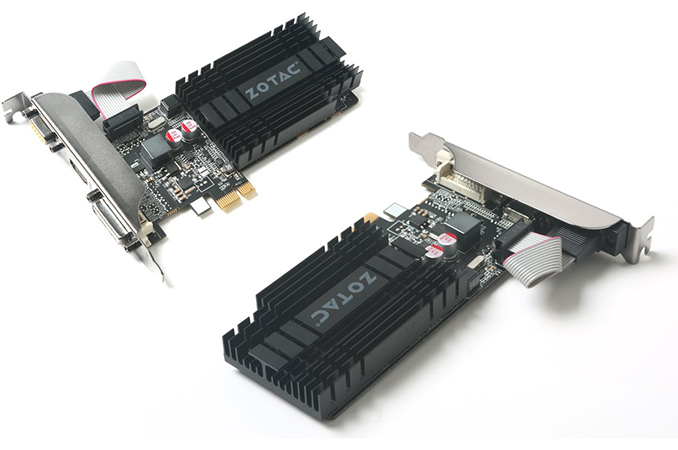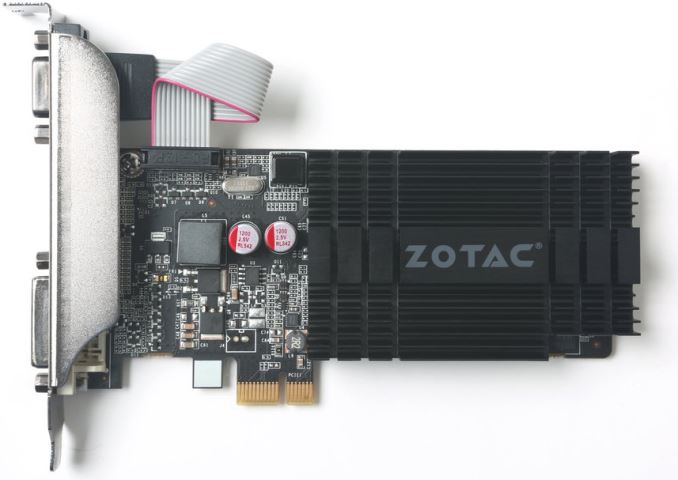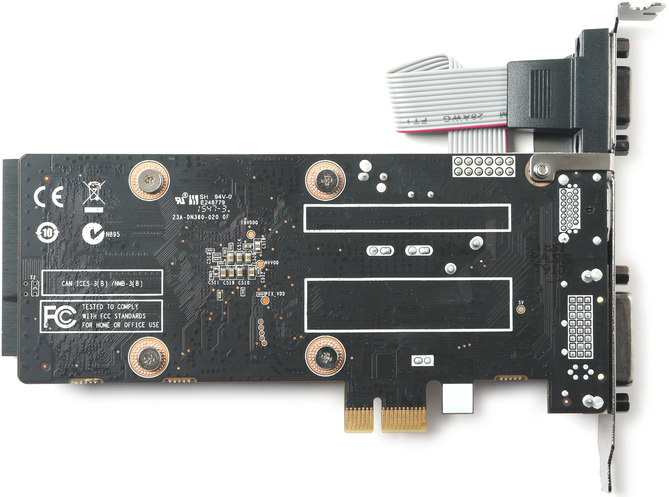ZOTAC Quietly Releases GeForce GT 710 Graphics Card with PCIe x1 Interface
by Anton Shilov on April 22, 2016 10:00 AM EST
ZOTAC has quietly introduced a new video card which is compatible with virtually every desktop PC released in the recent years. The new GeForce GT 710 graphics card with PCIe 3.0 x1 interface is not going to outperform modern higher-end iGPUs in games, but it will help owners of very low-cost systems, particularly those which may not even have a PCIe x16 slot, to add support for another display, or improve over the performance of completely outdated iGPUs.
The ZOTAC GeForce GT 710 1 GB (ZT-71304-20L) video card is powered by a cut-down version of NVIDIA’s GK208 GPU with 192 CUDA cores, 16 texture units and 8 ROPs. The GPU is based on the Kepler architecture, which supports Direct3D feature level 11_0, OpenGL 4.5 as well as OpenCL 1.2 APIs. The chip is clocked at 954 MHz and has compute performance of around 366 GFLOPS (well below that of modern iGPUs). The card is equipped with 1 GB of DDR3-1600 memory featuring 12.8 GB/s bandwidth.
The card comes in half height half length (HHHL) form-factor and is shipped with two brackets (for low-profile and standard PCs) to maximize compatibility with various computers. The graphics board has minimal (19W) power consumption and does not require active cooling (which means, it is also whisper quiet).
The main selling points of the ZOTAC GT 710 are its PCIe 3.0 x1 interface as well as three display outputs — DVI, HDMI 1.4 and D-Sub. Some entry-level PCs simply do not have PCIe x16 or x8 slots to install a graphics card, but virtually all desktops released in the last ten years have at least one PCIe x1 slot. ZOTAC’s new graphics card promises to be compatible with such systems. If owners of such PCs need to add one or two more display outputs, or just find their iGPUs too slow in Windows 10, they can buy the GeForce GT 710 1 GB PCIe 3.0 x1 graphics adapter. The board supports up to three displays, which should be enough for many workloads.
| NVIDIA GPU Specification Comparison | ||||||
| GT 710 | GT 720 | GT 630 | GT 610 | |||
| CUDA Cores | 192 | 192 | 192 | 48 | ||
| Texture Units | 16 | 16 | 16 | 8 | ||
| ROPs | 8 | 8 | 16 | 4 | ||
| Core Clock | 954MHz | 797MHz | 875MHz | 710MHz | ||
| Shader Clock | N/A | N/A | N/A | 1620MHz | ||
| Memory Clock | 1.8GHz DDR3 | 1.8GHz DDR3/ 5GHz GDDR5 | 1.8GHz DDR3 | 1.8GHz DDR3 | ||
| Memory Bus Width | 64-bit | 64-bit | 64-bit | 64-bit | ||
| VRAM | 1GB or 2GB | 1GB or 2GB | 1GB or 2GB | 1GB | ||
| TDP | 19W | 19W | 50W | 29W | ||
| GPU | GK208 | GK208 | GK107 | GF119 | ||
| Launch Timeframe | January, 2016 | March, 2014 | April, 2012 | May, 2012 | ||
| Launch Price | $30 - $50 | $49 | OEM | $49 | ||
When it comes to performance in games, it is unlikely that the GeForce GT 710 is fast enough for more or less demanding titles. The product may be faster than iGPUs integrated into entry-level Celeron or Pentium processors, but only in various online games that do not require a lot of GPU horsepower anyway.
As for market perspectives of ZOTAC’s GeForce GT 710 1 GB PCIe 3.0 x1, it should be noted that this is a niche product designed for owners of low-end systems, who need a better GPU or additional display outputs. Typically, people, who use such systems do not upgrade often, hence, ZOTAC’s new video card will hardly become a bestseller. Nonetheless, it will be a unique device for those who really need it.
ZOTAC does not list recommended prices on its web-site. However two stores which sell the device in Europe have it listed €58.30 ($65.8) and €84.7 ($95). This is definitely higher than you'd otherwise expect for a bottom-tier NVIDIA card, though it may very well be that retailers are counting on its unique nature.
Source: ZOTAC (via the Tech Report)

















55 Comments
View All Comments
DanNeely - Friday, April 22, 2016 - link
Closed back slots seem to've gone out of style (when PCIe first came into being they were relatively common in x1 and sometimes even x4); but OEMs are still putting stuff in the space where an x16 card connector would go. From the 4 most recently reviewed mobos:http://anandtech.com/show/10236/the-msi-z170a-sli-...
2 of 3 x1 slots are obstructed for x16 cards (1 battery, 1 m,2 screw post)
http://anandtech.com/show/10041/gigabyte-z170x-ud5...
2 of 3 x1 slots are obstructed for x16 cards (1 battery, 1 m,2 screw post). This one also has close backed slots.
http://anandtech.com/show/10264/the-gigabyte-mw31-...
1 of 1 x4 slots obstructed by the BIOS battery.
The fourth has 4 x16 slots making it mostly a moot point. It's 2 x1 slots don't have any crap in the way of an x16 cards connector; but both would be blocked by a 2 slot GPU.
http://anandtech.com/show/10206/the-asus-maximus-v...
LuxZg - Saturday, April 23, 2016 - link
Not all motherboards have open slots, and even when they do sometimes other components get in the way.And besides, PCIe was designed for the "other way around" compatibility. Meaning putting x1, x4, x8 all into x16 slot. The usage if x16 in x1 slot wasn't by design. There is a design of x16 physical connector but with just x4 or x1 paths. This is also something that PCIe switching allows for slots that can go from x16 to x8 or x4.
Anyway, long story short - if you want to use x16 graphics card in x1 slot on mbo you have way more chance to fail than to succeed... While putting x1 in x16 has to work by specification of the standard.
Bateluer - Friday, April 22, 2016 - link
Looks like the 710 is the same as the 720. Unless the 720 comes with GDDR5 more often than DDR3?watzupken - Friday, April 22, 2016 - link
I wonder how much better will this perform over the current gen iGPU. I don't think there is any incremental benefit at all.LuxZg - Saturday, April 23, 2016 - link
Please - review this if you can get one! This is not just for people with old computers, it can be used in servers fir some special cases, PCs for again special use where many displays are needed, and so on. These are all rare situations, but many such niche markets when combined make a relatively large market for such device. Just see the amount of comments on this "niche product" news article!Ian Cutress - Sunday, April 24, 2016 - link
What benchmarks? Just IGP gaming plus OpenCL?Ian Cutress - Sunday, April 24, 2016 - link
Inb4 folding. There's a new FAH benchmark iircDenithor - Tuesday, April 26, 2016 - link
Actually, that would be fine, but would prefer to see how these work for general HTPC duties. Image quality, 1080p30 / 1080p60 streaming, etc. I'm in a situation right now of needing a video card for my dad's pc to enable HDMI output to his TV. I'm curious if this would fit the bill for basic needs in this regard. Thanks! :)asmian - Thursday, April 28, 2016 - link
>does not require active cooling (which means, it is also whisper quiet)Well, if it doesn't have any fan, doesn't that mean it's actually SILENT? Whispers, however quiet, by definition involve noise. Fanless tech makes none. If the article is factually inaccurate about basic science, what hope should we have about the technical details? :(
ArdWar - Saturday, May 14, 2016 - link
Nah, air convection created by thermoshypon effect did move air and there bound to be some turbulence between the fins. Therefore creating a tiny amount of noise. It counts, heh... :D